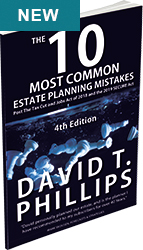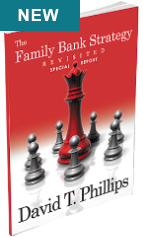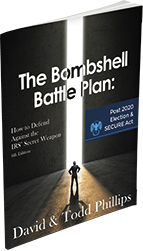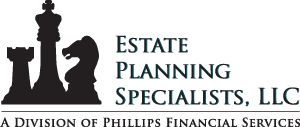
Bob Carlson's - Congress Plans to Kill the Stretch IRA, But You Can Do An End-Around

Congress Plans to Kill the Stretch IRA, But You Can Do An End-Around
We’re nearing a critical time for many Individual Retirement Account (IRA) owners. Advance IRA planning will be imperative if you want to maximize the after-tax value of your IRA for heirs and avoid the new tax burden Congress has in mind.
As I explained last month, despite the deadlock and division in Washington, the Setting Every Community Up for Retirement Enhancement (SECURE) act moved through the House of Representatives by a vote of 417 to 3 in May. A version of it is likely to pass the Senate and become law later this year. The SECURE Act and its Senate counterpart have a number of provisions designed to expand retirement savings opportunities and would delay required minimum distributions (RMDs).
To make up for the lost tax revenue, the SECURE Act and the Senate version would end the Stretch IRA. The Stretch IRA is a strategy in which children who inherit an IRA make maximum use of the tax code to minimize distributions for years. In many cases, the RMDs are less than the investment return of the IRA, so the IRA not only lasts for decades but increases in value. Under the SECURE Act, beneficiaries (other than minor children and a few other exceptions) would have to distribute and pay taxes on an inherited IRA within 10 years, even Roth IRAs.
There would be no taxes on the Roth IRA distributions. The Senate version wouldn’t apply the 10-year distribution requirement when the deceased’s IRAs were worth less than $450,000. Both versions would apply to any IRAs inherited after 2019.
Fortunately, there are strategies that will provide the advantages of a Stretch IRA even if Congress passes a version of these bills. These strategies also help you avoid the dreaded RMDs during your lifetime. Some of the strategies are best for people who have enough assets and income outside the IRA that they consider the IRAs to be for emergencies or something to leave their heirs.
To increase your family’s after-tax wealth, plan early and find the strategies that best fit your goals and situation.
Empty IRAs early. This is the simplest strategy and provides a lot of variations. This is what I recommended years ago before the other strategies were available.
You can empty the IRA in one lump sum or in installments over the years. You pay income taxes and invest the after-tax money, preferably in tax-advantaged ways. To protect the money from mistakes and waste by your heirs, you can put it in one or more trusts. The trust agreement and the trustee determine how the money is invested and when it is paid to the beneficiaries.
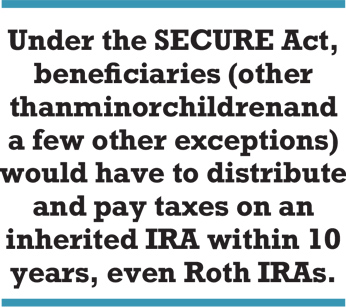
Convert to a Roth IRA. We discussed many times how to determine when converting a traditional IRA to a Roth IRA makes sense. In effect, you’re paying taxes for your heirs and setting them up for a stream of tax-free income. Unfortunately, the proposed limits on Stretch IRAs would apply to Roth IRAs as well as traditional IRAs. Your heirs still would have to distribute an inherited Roth IRA within 10 years under the SECURE Act.
IRA Leverage Strategy. You can guarantee your heirs will receive the current after-tax value of your IRA, and perhaps more. The guarantee holds regardless of what happens in the investment markets or with the IRA rules. Suppose Max and Rosie Profits are age 71. Max has a $1 million traditional IRA. He’ll soon have to take RMDs though he doesn’t need the income. Max and Rosie form a trust and name their two children as beneficiaries. They transfer the annual RMDs to the trust. There are no gift and estate taxes because of the annual gift tax exclusion, which is $15,000 in 2019.
The trust takes out a joint and survivor life insurance policy on Max and Rosie, naming the trust as beneficiary. Because of their ages and good health, the policy benefit is more than $1.4 million. Max and Rosie use the RMDs to make gifts to the trust that are used to pay the annual premiums on the policy. After Max and Rosie pass away, no matter when that is, the insurance company will pay more than $1.4 million to the trust, and the trust will use it for the beneficiaries or distribute it to them as called for in the trust agreement.
The insurance benefit will be tax-free to the trust and the beneficiaries. The beneficiaries will receive the face value of the insurance tax free. If they were to inherit a traditional IRA, they’d receive only the after-tax value of the IRA. Of course, if the Profits pass away before the IRA is depleted, the beneficiaries also will inherit what remains in the IRA.
The Family Bank Strategy. This is a variation of the IRA Leverage strategy. The main differences are the Profits don’t use a trust and buy a different type of permanent life insurance that would have a benefit of more than $1.5 million. The Profits hold the life insurance in their own names and continue to take the RMDs and use them to pay premiums on the life insurance. A potential advantage of this strategy is the life insurance policy builds up a cash value over the years. The Profits could tap into this account tax-free when needed to pay for their own expenses, family emergency expenses, or any other cash need that arises. If the cash value earns 6.98% annually, it would be worth almost $264,000 after 10 years.
The Profits could have the life insurance payable to their estate, to the beneficiaries, or to a trust. When paid to a trust, the insurance benefit becomes a family bank. The trustee distributes money to beneficiaries or pays expenses for their benefit as directed in the trust agreement. It also could make loans, such as to buy homes or start businesses. As the loans are repaid, the family bank is replenished and can benefit generations.
Note: The examples in the last two strategies assume the IRA owners are taking RMDs and use those to pay the insurance premiums. But there’s no reason to wait. Younger IRA owners can begin the strategies and take annual distributions from the IRAs to pay the premiums. In fact, the strategies provide more benefits the younger you are when they are initiated.
IRA Reboot. The IRA Reboot is an alternative to converting to a Roth IRA. Unlike a conversion, you have no out-of-pocket cost. Instead, you use several tax code provisions and a special type of life insurance policy to avoid paying the taxes out-of-pocket. The IRA Reboot is best explained through an example with Max Profits. Max is 65, in average health and in the 28% tax bracket. He has a $500,000 traditional IRA that he’s considering converting to a Roth IRA in stages over the next five years, which he thinks will keep him in the same tax bracket. Instead, Max opts to do the IRA Reboot over five years. In the first year, he transfers the IRA to a special qualified account. Then, he transfers $105,732 from the IRA into a Max-Funded Indexed Universal Life Policy with a benefit of more than $1.2 million. He transfers the same amount each of the following four years.
The transfers are IRA distributions and taxes are due by April 15 of the next year. At the end of the first year, Max is able to borrow from the insurer about $30,000 to pay the taxes. He does this each year. The loans are secured by the cash value of the policy and remain outstanding until Max passes away. They will be subtracted from the life insurance benefits paid on the policy.
The result is Max converted the IRA to a life insurance policy without using any of his cash to pay taxes on the conversion. The after-tax amount his heirs receive, after paying the outstanding loans, will be higher than the original value of the IRA and will be tax free. Also, the insurance policy has a cash value account. Max can take money from the cash account to pay expenses or convert it into a guaranteed lifetime tax-free income stream. In fact, his net cash account will top $318,000 in 10 years and $608,000 in 20 years, all net of the loans he used to pay the conversion taxes in years two through six. Max also can add a long-term care benefit to the insurance policy if he’s qualified. The benefit will either increase the premium or reduce the insurance benefit.
The charitable trust bailout. When you want to benefit one or more charities in addition to your loved ones, consider converting your traditional IRA into a charitable remainder trust (CRT). Under one strategy, your estate planner drafts the CRT as part of your will or estate plan, and you name the CRT as the beneficiary on the beneficiary designation form. After you pass, the entire IRA is distributed to the CRT.
The CRT pays income to a beneficiary or beneficiaries you named in the trust. Typically, a CRT pays a percentage of the trust assets to the beneficiary for life. The annual payouts rise and fall with the value of the trust. An alternative is for the trust to pay a fixed annual amount to the beneficiary. IRS regulations limit the amount of income that can be paid to the beneficiary. After the beneficiary passes away, the remainder of the trust is donated to the charity.
If your estate planner runs the numbers, they should show that your beneficiary receives more after-tax money under the CRT than if the IRA is liquidated within the time frame required by the SECURE Act. You’ve provided for your loved ones, protected the assets, and also provided for charity. The conversion to a CRT also can be done during your lifetime. You can take a distribution of all or a large portion of the IRA and immediately transfer the after-tax amount to a CRT. The CRT pays annual income to you (or you and your spouse) for life. Many people then have the remainder in the CRT paid to charity. To ensure their heirs have an inheritance, they purchase a permanent life insurance policy when the CRT is created and name their children as the beneficiaries. amount contributed to the trust. The deduction is the present value of the amount the charity is expected to receive in the future. Current interest rates and tables issued by the IRS are used to determine the deduction. The older you are, the larger the percentage of the contribution you can deduct.
There are other ways to structure the conversion of an IRA to a CRT. These are the most frequently used strategies. If any sound appealing, discuss the alternatives with your estate planner. Most large charities have offices that will manage and administer a CRT for little or no money when they are named as a beneficiary.
Charity as IRA beneficiary. The simplest strategy is to make post-mortem charitable gifts through an IRA. You can set up a separate IRA that has roughly the amount you want the charity to receive and name the charity as the beneficiary. Or you can name the charity as one of several beneficiaries for an IRA, noting either the dollar amount or the percentage of the IRA you want the charity to receive. After you pass, the charity takes a distribution of its share of the IRA. Since the charity is tax-exempt, it doesn’t owe any income taxes and receives the full benefit of the distribution.
When your children or other loved ones inherit an IRA, they include the distributions in gross income and owe income taxes on them. They really inherit only the after-tax value. But when they inherit non-IRA assets, they increase the tax basis to the current fair market value. They can sell the assets right away and won’t owe any capital gains taxes on the appreciation that occurred while you You include the IRA distribution in gross income. If you itemize expenses on your tax return, you receive a charitable contribution of part of the owned the property.
If you’re going to make a straightforward charitable contribution through your estate, it’s better to make them through an IRA than the rest of the estate.
Most of these are not do-it-yourself strategies. You need to work with a financial advisor who knows the strategies, especially those involving life insurance. There is more information, along with detailed examples of several of these strategies, in the report The Bombshell Battle Plan: How to Defend Against the IRS’ Secret Weapon by David Phillips and Todd Phillips. You can receive it for only $6.95 by calling 888-892-1102 and identifying yourself as a Retirement Watch reader.
